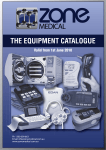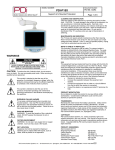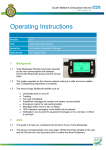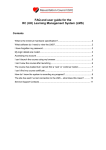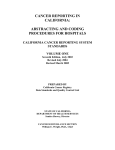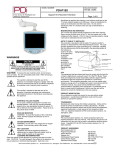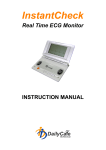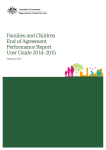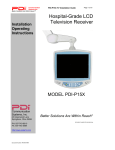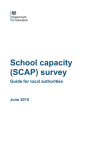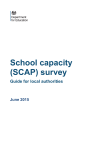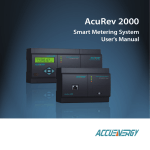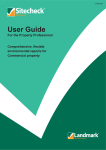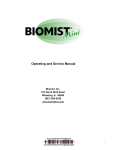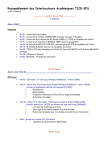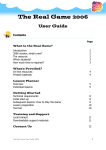Download Automated external defibrillators – a guide for schools
Transcript
Automated external defibrillators (AEDs) A guide for schools October 2015 Contents Purpose and introduction 4 Who is this guide for? 5 Review date 5 Acknowledgements 5 Cardiac arrest and heart attacks 6 Cardiac arrest 6 Heart attack 6 The chain of survival 8 Defibrillation and cardiopulmonary resuscitation (CPR) 9 Purchasing an AED 10 Ordering from NHS Supply Chain 11 Location and access 13 Choosing a location 13 Installing your AED 13 Community access 15 Example scenarios 15 Example A 16 Example B 16 Training 18 Is training required? 18 Sources of training 18 Raising awareness 18 British Heart Foundation CPR training pack for secondary schools 19 Additional considerations 20 Developing an action plan 20 After an incident 20 Safety considerations 21 Legal considerations 21 2 Accessories and consumables 22 Maintaining your AED 24 Regular maintenance 24 Replacing consumables 24 Software updates 25 Replacing your AED 25 Sources of further information 26 Departmental advice and guidance 26 Other publications 26 Local ambulance services 26 External organisations 26 Annex A: AED minimum specification 27 Annex B: support arrangements for AEDs purchased under the DfE arrangements 30 3 Purpose and introduction This guide is intended to provide schools with an overview of the various issues they may wish to consider when installing and maintaining automated external defibrillators (AEDs) on their premises. The information provided is not definitive as decisions relating to the purchase and installation of AEDs are entirely for schools to determine. However, we hope that schools will find the information useful in understanding the role that AEDs can play in ensuring the health and safety of pupils, staff and other users of their premises. An AED is a machine used to give an electric shock when a person is in cardiac arrest, i.e. when the heart stops beating normally. Cardiac arrest can affect people of any age and without warning. If this happens, swift action in the form of early cardiopulmonary resuscitation (CPR) and prompt defibrillation can help save a person’s life. In 2013, emergency medical services attempted to resuscitate approximately 28,000 cases of out-of-hospital cardiac arrest in England. 1 Overall survival rates vary across the country, but range between 2% and 12%. 2 However, survival rates as high as 75% have been reported where CPR and defibrillation are delivered promptly. 3 This is why the statutory guidance on supporting pupils at school with medical conditions 4 advises schools to consider purchasing an AED as part of their first-aid equipment. Research has shown that an individual’s chance of survival following the onset of a cardiac arrest decreases by 7–10% for every minute of delay in commencing treatment.2 Lack of blood circulation for even a few minutes may lead to irreversible organ damage – including brain damage. Early intervention by bystanders, even those with little or no firstaid training, can therefore buy time until professional help arrives, improving the chance of a successful outcome. Modern AEDs are inexpensive, simple to operate and safe for users. The AED will analyse the individual’s heart rhythm and apply a shock to restart it, or advise that CPR should be continued. Voice and/or visual prompts will guide the rescuer through the entire process from when the device is first switched on or opened. These include positioning and attaching the pads, when to start or restart CPR and whether or not a shock is advised. 1 Source: Consensus Paper on Out-of-Hospital Cardiac Arrest in England (British Heart Foundation, NHS England and Resuscitation Council (UK), 2014): https://www.resus.org.uk/publications/consensus-paperon-out-of-hospital-cardiac-arrest-in-england/ 2 Source: Deakin, Shewry, Gray, ‘Public access defibrillation remains out of reach for most victims of outof-hospital sudden cardiac arrest’, Heart, 100 (2014), 619–623: http://heart.bmj.com/content/100/8/619.full?sid=bbc35314-f031-4b10-957d-8568b7034530 3 Source: Jerry P. Nolan (ed.), Resuscitation Guidelines 2010 (London: Resuscitation Council (UK), 2010), p. 29. 4 Available online at https://www.gov.uk/government/publications/supporting-pupils-at-school-with-medicalconditions--3. 4 For schools that would like assistance with purchasing an AED, the Department for Education has negotiated an arrangement with NHS Supply Chain to enable the purchase of AEDs which meet a certain minimum specification at a discount. Further details can be found in the ‘Purchasing an AED’ section on page 10. Who is this guide for? This guide has been produced to meet the needs of maintained schools and academies in England. Other settings are also welcome to make use of the information, but should be aware that not all of it will be relevant to them. The purchasing arrangements on pages 10 and 11 are available to the following types of settings in all nations of the UK: • maintained schools • academies • independent schools • sixth-form and further education colleges • maintained and independent nursery schools • pre-school establishments • private, voluntary and independent nurseries • playgroups • holiday and out-of-school providers The arrangements are also open to other organisations (such as local authorities, multiacademy trusts and parents’ associations) purchasing on behalf of such establishments. Details of the school or other eligible setting will be required at the time of purchase. Review date The ‘Purchasing an AED’ section of this document will be updated on a regular basis to reflect the purchasing arrangements put in place by the Department for Education. Other sections of the guide will next be reviewed no later than September 2016. Acknowledgements We are grateful to our colleagues at the Department of Health, various NHS ambulance services and a wide range of voluntary and community sector organisations for their invaluable support and assistance in producing this guide. 5 Cardiac arrest and heart attacks It is important to understand the distinction between a heart attack and cardiac arrest as they are not the same, and require different interventions. CPR and/or the use of an AED is not appropriate for an individual experiencing a heart attack and who is conscious, as the heart will still be beating, and the device will not administer a shock in these circumstances. However, a heart attack is still a life-threatening situation, and the emergency services should be alerted immediately. A heart attack can also very quickly lead to cardiac arrest, in which case administration of CPR and use of an AED may help to save the person’s life. Cardiac arrest Cardiac arrest is when the heart stops pumping blood around the body. It can be triggered by a failure of the normal electrical pathway in the heart, causing it to go into an abnormal rhythm or to stop beating entirely. Oxygen will not be able to reach the brain and other vital organs. When a cardiac arrest occurs, the individual will lose consciousness and their breathing will become abnormal or stop. If basic life support is not provided immediately, the chances of survival are greatly reduced. Cardiac arrest can happen at any age and at any time. Possible causes include: • heart and circulatory disease (such as a heart attack or cardiomyopathy) • loss of blood • trauma (such as a blow to the area directly over the heart) • electrocution • sudden arrhythmic death syndrome (SADS; often caused by a genetic defect) When a cardiac arrest occurs, CPR can help to circulate oxygen to the body’s vital organs. This will help prevent further deterioration so that defibrillation can be administered. Heart attack A heart attack (sometimes referred to as a myocardial infarction), is caused by a clot forming in one of the arteries that supply blood to the heart muscle. This prevents oxygen from getting to a particular region of the heart. As a result, cells in this region start to die. The longer this continues, the more damage is caused to the muscle. This damage is 6 permanent. However, as the heart is still beating, CPR and defibrillation are not appropriate. Not all people experiencing a heart attack will experience pain or discomfort. They will often remain conscious throughout. However, a heart attack is a serious, life-threatening emergency that requires immediate treatment and can trigger a cardiac arrest. If a person experiences a heart attack, the correct course of action is to call 999 immediately. The person should be made comfortable, ideally seated on the floor supported by a wall or a person knelt behind them, and reassured until the ambulance arrives. Heart attacks are very rare among children, but the number of incidents in the adult population means that coronary heart disease (the most common cause of heart attacks) is the leading cause of death in the UK. 5 Common symptoms of a heart attack include: • chest pain or tightness, like a belt or band around the chest, and which is not relieved by rest • pain which may spread to neck, jaw, back and arms • feeling sick, sweaty, short of breath, lightheaded, dizzy or generally unwell along with discomfort in the chest 5 Source: NHS Choices web page on coronary heart disease: http://www.nhs.uk/Conditions/Coronaryheart-disease/Pages/Introduction.aspx 7 The chain of survival In the event of a cardiac arrest, defibrillation can help save lives, but to be effective, it should be delivered as part of the chain of survival. Figure 1: The chain of survival Reproduced courtesy of Laerdal Medical There are four stages to the chain of survival, and these should happen in order. When carried out quickly, they can drastically increase the likelihood of a person surviving a cardiac arrest. They are: 1. Early recognition and call for help. Dial 999 to alert the emergency services. The emergency services operator can stay on the line and advise on giving CPR and using an AED. 2. Early CPR – to create an artificial circulation. Chest compressions push blood around the heart and to vital organs like the brain. If a person is unwilling or unable to perform mouth-to-mouth resuscitation, he or she may still perform compression-only CPR. 3. Early defibrillation – to attempt to restore a normal heart rhythm and hence blood and oxygen circulation around the body. Some people experiencing a cardiac arrest will have a ‘non-shockable rhythm’. In this case, continuing CPR until the emergency services arrive is paramount. 4. Early post-resuscitation care – to stabilise the patient. Anyone is capable of delivering stages 1 to 3 at the scene of the incident. However, it is important to emphasise that life-saving interventions such as CPR and defibrillation (stages 2 and 3) are only intended to help buy time until the emergency services arrive, which is why dialling 999 is the first step in the chain of survival. Unless the emergency services have been notified promptly, the person will not receive the post-resuscitation care that they need to stabilise their condition and restore their quality of life (stage 4). The chain as a whole is only as strong as its weakest link. Defibrillation is a vital link in the chain and, the sooner it can be administered, the greater the chance of survival. 8 Defibrillation and cardiopulmonary resuscitation (CPR) When a person suffers a cardiac arrest, it is essential for effective CPR to be initiated as soon as possible; only dialling 999 should take precedence. The person performing CPR should not stop except where this is necessary in order to attach the pads or when instructed to do so by the AED, usually before it delivers a shock. If possible, somebody else should attach the pads to the patient while CPR continues. Figure 2: Adult AED pad placement Figure 3: Paediatric AED pad placement (for use on children aged up to 8 years of age, or weighing under 25 kg) 6 Reproduced courtesy of the Resuscitation Council (UK) An AED will only administer a shock if the patient’s heart is in a shockable rhythm. The application of CPR can maximise the opportunities for defibrillation to be administered effectively. The AED will continue to analyse the patient’s heart rhythm after each shock and will provide ongoing instructions about continuing CPR. Some cardiac arrest patients will not present with a shockable rhythm (i.e. one which is suitable for defibrillation), and the AED will not administer a shock. In such cases, it is essential that CPR is maintained until the emergency services arrive. 6 The aim is to place the pads so that the heart is in a direct line between the faces of the two pads. In infants and small children it is best to apply the pads to the centre of the chest, one on the child’s front and one on the child’s back, if they cannot be separated adequately in the standard positions shown here. 9 Purchasing an AED In view of the vital role that AEDs can play in saving the lives of pupils, staff and other users of school premises, the Department for Education is encouraging all schools to consider purchasing these devices as part of their first-aid equipment. For schools and other eligible settings that would like assistance to do this, the Department for Education, working with the Department of Health, has negotiated an arrangement with NHS Supply Chain for schools to purchase AEDs from them at reduced cost. The devices on offer must meet the minimum specification provided at annex A. NHS Supply Chain, under contract with the Department of Health, has a procurement framework agreement in place with a wide range of AED suppliers. In order to secure the best possible prices, NHS Supply Chain purchases AEDs in batches. Suppliers on the framework with devices that meet the minimum specification are invited to compete for each batch via an online ‘reverse’ auction. This is where bids decrease as the auction progresses, with the eventual winner being the supplier willing to sell devices at the lowest price. The discount achieved from purchasing in bulk is passed on to schools through a reduced unit price. However, prices are likely to vary as each batch is purchased separately. The model of AED supplied may also change from batch to batch, although all devices supplied must still meet the minimum specification. The current batch (batch two) went on sale on 25 June 2015 for £452.78 (excl. VAT) per AED. With effect from 1 October 2015 the price per unit has been reduced to £439.49 excl. VAT (£527.39 incl. VAT) for the Mediana HeartOn A15 AED. This price includes delivery costs. The package includes: • 1 x automated external defibrillator (AED) • 1 x carry case • 1 x battery • 1 x set of universal pads (a switch on the device is used to change between adult and paediatric modes) • user guide (user instruction manual in hard or soft copy format) • 1 x laminated AED wall sign Replacement consumables may also be available to users of these arrangements at reduced cost. Further information can be found in the ‘Replacing consumables’ section on page 24 and annex B on page 30. Purchasing an AED is entirely voluntary and there is no requirement to do so via NHS Supply Chain. Should schools or other settings decide to purchase a defibrillator from another supplier, they may find the minimum specification attached at annex A helpful 10 when assessing their needs and to ensure that the AED they wish to purchase represents value for money. They may also wish to consult their local ambulance service, who will be able to provide details of any preferred models currently used in the local area. It is possible that local ambulance services and/or voluntary and community sector organisations may be able to support funding for community-access defibrillators. Schools and other settings wishing to pursue this option are advised to contact the relevant bodies directly. Ordering from NHS Supply Chain All schools in the UK, including maintained schools, academies and independent schools, are able to purchase AEDs from NHS Supply Chain under the arrangements put in place by the Department for Education. The arrangements are also open to: • sixth-form and further education colleges • maintained and independent nursery schools • pre-school establishments • private, voluntary and independent nurseries • playgroups • holiday and out-of-school providers The arrangements are also open to other organisations (such as local authorities, multiacademy trusts and parents’ associations) purchasing on behalf of such establishments. Details of the school or other eligible setting will be required at the time of purchase. To place an order, schools and other educational institutions should contact NHS Supply Chain directly by calling 0113 385 4858 or emailing [email protected]. NHS Supply Chain will ask you to provide: • the name and address of your school or other eligible setting • your school’s six-digit URN (where applicable) 7 • the name of your local authority (note that this applies regardless of setting type) • the type and phase of your school or other setting • a named contact for further correspondence 7 You can find your school’s URN by consulting EduBase: http://www.education.gov.uk/edubase/home.xhtml. 11 • an email address and telephone number Once the order has been placed, you will receive a confirmation email from NHS Supply Chain within two working days. Delivery will be direct from the supplier, and will normally be within two weeks. Should you encounter any issues when purchasing your AED or wish to cancel your order, please contact NHS Supply Chain using the contact details above. For technical support, please contact the device supplier directly. Contact details for the supplier of each batch can be found in annex B on page 30. 12 Location and access Choosing a location In view of the importance of responding swiftly to a cardiac arrest, AEDs should be located strategically to ensure that they can be accessed quickly in an emergency. Schools may decide to have a number of AEDs to ensure easy access from anywhere on the school premises. Where complete coverage cannot be provided, devices should ideally be situated no further than a maximum of two minutes’ brisk walk from the areas where they are most likely to be needed. This might include sports facilities and play areas (physical activity is linked to an increased likelihood of cardiac arrest), as well as the routine locations of any pupils or staff known to have existing heart conditions. All proposed AED locations should be subject to a risk assessment, taking into account: • availability for timely deployment (including the likely time required to climb stairs, open doors, etc.) • health and safety risks (e.g. slip, trip and fall hazards) • safety and security (Is the area well-lit? Does the location render the AED susceptible to tampering or vandalism and, if so, what measures would be proportionate to counter that risk?) Schools should always ensure that the local ambulance service is informed of the make, model and location of the AED, and any access arrangements, in order to assist 999 operators and ambulance crews. If an AED is temporarily removed from its usual location other than in an emergency (for example, in order to provide cover at a sports event elsewhere on the school site) then it would be considered good practice to display a prominent notice to this effect in its usual location, giving details of an appropriate telephone number on which the member of staff who holds the AED can be contacted. Schools may wish to consult their local ambulance service to find out whether it is necessary to inform them when an AED has been temporarily relocated elsewhere on the school premises. Installing your AED AEDs are standalone devices and do not require any particular type of enclosure or mounting if they are to be kept in normal indoor conditions. However, it may be helpful for the sake of convenience and visibility if they are kept in a specially designed wall mount or cabinet. Most manufacturers can supply these, although schools may well find that alternatives from third-party manufacturers are considerably cheaper. Schools should always check with the supplier from whom they intend to purchase the wall mount or cabinet that it is the correct size and shape for the AED model for which they plan to use it. 13 If an AED is to be located outdoors, most manufacturers would advise that it is kept in a heated cabinet. This is because the electrode pads may not function as effectively if they fall below a certain temperature, normally 0 ºC, although they will still deliver a shock. A heated cabinet will require a power supply. Lockable and/or alarmed cabinets are available to deter tampering, but security considerations will need to be balanced against the need to access the AED quickly in the event of an emergency. In terms of accessibility, we would recommend that devices should not be locked away if at all possible. An unlocked cabinet with an alarm may represent a good compromise if tampering is a concern. Where a lockable cabinet is deemed necessary, schools should seek advice from the local ambulance service on how best to minimise the delay to the user in accessing the AED. Options for consideration may include: • installing a cabinet with a key-based lock and mounting a key in a prominently visible break-glass box next to the cabinet • installing a coded cabinet, and ensuring that all school staff and the local ambulance service are aware of the access code; a notice should be displayed on the cabinet to inform users that they can obtain the access code by dialling 999 All cabinets and wall brackets should be clearly marked using a standard sign for AEDs. The design recommended by the Resuscitation Council (UK) is shown below. 8 Some suppliers may provide this as part of the AED purchase. Figure 4: The UK standard sign for AEDs Reproduced courtesy of the Resuscitation Council (UK) 8 A different design has been approved by the International Liaison Committee on Resuscitation (ILCOR). Although the ILCOR design meets the relevant legal requirements, its use is not endorsed by the Resuscitation Council (UK). 14 Schools may also wish to include a further sign with the following or similar wording: • training is not required to use this device • if someone is unconscious and not breathing normally, dial 999 immediately; the operator will explain when and how to perform CPR and use this defibrillator Carry cases are also available for most AEDs and their accessories. A carry case is not generally necessary if the device is to be kept in a cabinet, but may be required if the AED is to be kept in a wall mount. A carry case may also prove useful if the school chooses to temporarily relocate an AED to provide cover at a sporting event, or to acquire a spare AED for use on school trips. Community access Schools are at the heart of their communities. They may therefore wish to consider placing an AED in a location which is externally accessible at all times, allowing it to be used for incidents occurring off school premises, and outside school hours. This can be particularly beneficial in areas where ambulance response times are typically longer. However, the primary concern should be locating the device where it will best meet the needs of the school. Any location chosen for a community-access AED should be subject to a rigorous risk assessment in terms of both its accessibility and any measures required to reduce the risk of theft or vandalism. Local ambulance services and/or voluntary and community sector organisations may be able to advise in this regard. A school’s insurance arrangements will normally cover devices located inside their premises. However, any devices, accessories or cabinets (whether locked or unlocked) located outside the school boundary (defined as the enclosed area containing the school, as opposed to merely the land which is owned by the school) are unlikely to be covered by the school’s insurance, and will not be covered by the Department for Education’s risk protection arrangement (RPA) for participating academies. In these circumstances, the school will be solely responsible for repair or replacement costs in the event of theft or vandalism. Schools may therefore wish to check with their insurance provider before choosing to locate an AED in a publicly accessible location. It should nevertheless be noted that ambulance service figures indicate that the incidence of AED theft is generally very low. AEDs cannot lawfully be sold without the relevant supporting documentation, rendering stolen devices extremely difficult to sell on. Example scenarios The following examples illustrate some of the factors which schools may wish to take into account when choosing where and how to install an AED. 15 Example A A primary school with approximately 130 pupils is situated right in the heart of a small market town. The local church is opposite, and there are a number of small shops nearby. The school wanted its AED to be available to the wider community. Their local ambulance service advised on a suitable location for the device, and a cabinet to house the AED was installed on an external wall in a location adjacent to the school’s main entrance and easily accessible from the road. It takes approximately one minute to get from the playground to the AED, even though there are two doors en route. Because the device would need to be accessed quickly in an emergency, the school decided that a locking cabinet would be disproportionate – especially given the relatively low crime rate in the area. They did, however, opt for an alarmed model as a precaution in order to discourage tampering. Because the location is exposed, they also decided that the cabinet should be heated. The school drew up an action plan, so that staff would know what to do if someone had a cardiac arrest. The ambulance service also added the AED to its computer system, so that 999 operators could direct callers to it if required and talk them through how to use it. Example B An urban secondary school has around 1,800 pupils, and is housed in a number of buildings on a single site. They held a risk assessment which determined that a single AED would be insufficient for their needs. The school therefore purchased three AEDs and located these at key strategic points on the school premises, with clear signage to ensure that they can easily be found in an emergency. Because there is a link between physical activity and an increased likelihood of cardiac arrest, the school placed the first AED just inside the PE block, adjacent to the gym and overlooking the playing fields. With the exception of the gym, the PE block is frequently left unattended, so the school decided to house the device in a non-lockable, alarmed cabinet to deter tampering. The second AED was located in a connecting corridor between the science and humanities blocks. This is at the heart of the school, and can be accessed quickly from a large number of classrooms. Because the corridor is heavily frequented by both staff and pupils, it was decided that there was no need for the cabinet to be alarmed. The third AED was sited in the reception area, close to the school hall and the classroom of a member of staff who had recently suffered a heart attack. Although easily accessible, this area is rarely visited by pupils, but the reception desk is almost always attended during school hours. The school therefore chose to install this AED in a simple wall mount, as the risk of tampering is low. 16 All the devices were registered with the local ambulance service, from whom a small number of school staff also received training, which they disseminated to other staff. The school also drew up a procedure for staff to follow in the event of an emergency. 17 Training Is training required? AEDs, as work equipment, are covered by the Provision and Use of Work Equipment Regulations 1998 (PUWER), and as such this places duties on employers in respect of employee training and the provision of information and instructions in the use of such equipment. However, AEDs are designed to be used by someone without any specific training and by following step-by-step instructions on the AED at the time of use. It should therefore be sufficient for schools to circulate the manufacturer’s instructions to all staff and to provide a short general awareness briefing session in order to meet their statutory obligations. Schools may want to use this opportunity to raise awareness of the AED in school and to promote its use should the need arise. The awareness briefing may also be incorporated into any wider training on CPR and the chain of survival. Sources of training Many local ambulance services are able to advise schools on accessing free or low-cost training in the use of AEDs and in CPR. 9 In some areas, this role may instead be fulfilled by the local IMPS (Injury Minimization Programme for Schools) programme. 10 Schools may also be able to access training through their local authority. Many voluntary and community sector organisations also offer training. A number of such organisations can be found on page 26 of this guide, although it should be noted that not all of those listed will offer training. Schools may also wish to contact the supplier of their AED to ask what training is available through them. Other private-sector training providers are also available. 11 Raising awareness Schools may wish to consider raising AED awareness, along with CPR training, across the entire school community to ensure that there is a greater likelihood of being able to assist someone suffering a cardiac arrest in time to save their life. The Resuscitation Council (UK) states that untrained bystanders should not be discouraged from using an 9 A list of local ambulance services, including contact details, can be found on the NHS Choices website at http://www.nhs.uk/servicedirectories/pages/ambulancetrustlisting.aspx. 10 For information on local IMPS programmes, please visit http://www.impsweb.co.uk. 11 For details of the considerations a school may wish to take into account when selecting a private-sector training provider, please visit http://www.hse.gov.uk/firstaid/approved-training.htm. 18 AED in an emergency. Nevertheless, individuals who have received training will naturally feel more confident in doing so should the need arise. One way in which this might be done is through personal, social, health and economic (PSHE) education, which all schools should provide. The PSHE Association’s suggested programme of study includes emergency life-saving skills as part of PSHE provision. Schools may want to consider using/contacting organisations such as the local IMPS programme, Arrhythmia Alliance, the British Red Cross, the Royal Life Saving Society UK and St John Ambulance, who may be able to provide suitable resources and/or training. Their contact details can be found on page 26. Secondary school pupils and older primary school children are generally capable of sufficiently compressing the chest to the correct depth and speed in order to successfully administer CPR. CPR training can also give children the confidence and skills to talk an adult through the administration of CPR. Younger primary-aged children frequently lack the physical strength to carry out CPR on adults, so general awareness training (including, for example, how to dial 999 and put someone in the recovery position) may be considered more appropriate for this age group. Schools may also choose to make their facilities available to host CPR and AED awareness sessions for members of the local community. This may be of particular benefit where the school has chosen to make an AED publicly accessible. British Heart Foundation CPR training pack for secondary schools As part of its work to help people survive an out-of-hospital cardiac arrest, the British Heart Foundation is offering CPR training packs free to all secondary schools in the UK. Each school that applies will receive a pack of 35 kits, each containing a lightweight manikin and a 30-minute DVD which includes familiarisation on the use of AEDs – enough to allow every young person in a class to learn CPR first-hand. Secondary schools can order kits through the British Heart Foundation website at http://www.bhf.org.uk/lifesavers. 19 Additional considerations Developing an action plan Schools may find it helpful to develop and implement a resuscitation action plan to facilitate a swift response to incidents of cardiac arrest. This might cover issues such as how to initiate the chain of survival and how to keep children away from the scene. A resuscitation plan may also set out best practice, including how and by whom tasks should be carried out. For example, if one person is on the scene, they should immediately call the emergency services (step 1 of the chain of survival) and start CPR immediately afterwards (step 2). If two people are on the scene, one should call the emergency services while the other starts CPR. The person administering CPR should not leave the casualty unless absolutely essential. Where possible, it is suggested that arrangements are implemented to enable the AED to be brought to the scene by someone already close to its usual location, as this is likely to be quicker than sending somebody to fetch it. If this is not practical, the rescuer should remain with the casualty and a second individual should be sent to fetch the AED. When developing a resuscitation plan, schools may find it helpful to refer to the chapter entitled ‘Adult Basic Life Support’ in the Resuscitation Guidelines 2010. A link to these can be found under ‘Other publications’ on page 26. After an incident Assisting an individual who has suffered a cardiac arrest can be a stressful experience for the rescuer. Should a rescuer need support after an incident, they may be able to request a debriefing from the local ambulance service. Alternatively, they can seek help from their GP. Most AEDs will store data, which can subsequently be used to assist with ongoing patient care. Schools should therefore contact the local ambulance service after an AED has been used and make arrangements for the data to be downloaded. In the meantime, the AED may still be used if required, but care should be taken not to turn it on and off unnecessarily as this could potentially erase the data. Schools should ensure that the AED is ready for use again by replacing pads and other consumables as required, and ensure that it is not displaying any warning lights or messages. Schools should also be aware that where a cardiac arrest occurs as a result of an accident or act of physical violence arising out of or in connection with work, this may constitute a reportable incident under the Reporting of Injuries, Diseases and Dangerous Occurrences Regulations 2013 (RIDDOR). Reporting requirements will differ according to whether the individual suffering the cardiac arrest is an employee (e.g. a teacher or member of support staff) or a non-employee (e.g. a pupil, parent or visitor). Further 20 information can be found in the Health and Safety Executive guidance on incident reporting in schools 12. Safety considerations AEDs are safe to use for all those involved, and will give a verbal warning instructing the rescuer to stand back when analysing heart rhythm and prior to delivering a controlled electric shock. A rescuer may accidentally be subjected to a defibrillation shock if he or she does not heed this warning, but this is unlikely to cause significant harm. Standard AEDs are suitable for use on people of all ages, except small children aged under 12 months. For children aged 1–8, it is recommended that AEDs be used in paediatric mode or with paediatric pads. However, adult pads may be used if paediatric pads are not available. Rescuers should not hesitate to use an AED on a pregnant woman in cardiac arrest, as resuscitation of the pregnant mother is the only way to keep her unborn child alive. Early defibrillation can therefore help provide the best chances of survival for both the unborn child and the mother. When calling 999, it is advisable to notify the operator that the casualty is pregnant as this may determine which response crew/vehicle is required. Legal considerations We understand that schools may have concerns about the legal risks – if any – of attempting resuscitation and using an AED. The Department for Education is unfortunately not in a position to provide advice on these issues. However, schools may find it helpful to refer to the Resuscitation Council (UK) and its associated publications, for example The legal status of those who attempt resuscitation 13. 12 13 Available online at http://www.hse.gov.uk/services/education/index.htm. Available online at https://www.resus.org.uk/cpr/legal-status-of-those-attempting-cpr/. 21 Accessories and consumables Every AED should be kept with a number of accessories/consumables to ensure that it is always ready for use. Item description Electrode pads Generally supplied with AED as standard? Notes Adult: yes These are adhesive pads which are applied to the 14 Paediatric: no casualty’s chest and through which the shock is delivered. They will include a cable for connection to the AED. Most AEDs require separate pads for adult and paediatric use (children aged 1–8). Where this is the case, schools should ideally put arrangements in place to ensure that they have at least one set of each available and that these are stored with the AED. In the event that paediatric pads are not available in an emergency situation, adult pads can be used. Schools should preconnect adult pads to an AED to ensure that the device is ready to use more quickly in the event of an emergency. Most AEDs require pads to be preconnected in order to conduct regular self-tests. Paediatric pads are not recommended for preconnection as the majority of cardiac arrests occur in adults and paediatric pads will be ineffective if used on an adult. Pad positioning will generally be shown on the AED or the pad packaging. The pads themselves may be labelled ‘left’ and ‘right’, but it does not matter if they are accidentally inverted – they will still work. 14 Where separate paediatric pads are required, these are not generally included with an AED at the time of purchase. All suppliers providing AEDs as part of the arrangements put in place by the Department for Education must, however, include a set of paediatric pads as standard if required. 22 Item description Generally supplied with AED as standard? Notes Key for switching No 15 between adult and paediatric modes AEDs that do not require separate adult and paediatric pads will sometimes require a key to switch between adult and paediatric modes. Scissors No These will enable rescuers to cut away a casualty’s clothing if required. Protective gloves No Rescuers may wear protective gloves to guard against infection if desired, but these are not necessary. The risk of infection is very low. Towel or dry wipes No If the casualty is wet, a towel or dry wipes should be used to dry the chest in order to ensure that the pads are able to adhere properly. Pads need to have good contact with an individual’s skin in order to effectively analyse his or her heart rhythm. Safety razor No Pads are designed to function with chest hair, but excessive amounts may prevent them from adhering to the casualty’s chest and impair conductivity. In these situations, a safety razor should be used to dry-shave excessive chest hair where the electrodes are to be applied. Pocket mask/ face shield No Rescuers may wear a pocket mask or face shield to guard against infection while administering mouth-to-mouth resuscitation if desired, but this is not necessary. The risk of infection is very low. If a person is unwilling or unable to perform mouthto-mouth resuscitation, he or she may still perform compression-only CPR. Schools are advised to keep minimum supplies of spare electrode pads, protective gloves, safety razors, pocket masks/face shields and dry wipes (if applicable) on-site so that the AED is not left unusable whilst awaiting replacements. Further information on consumable shelf life can be found in the ‘Replacing consumables’ section on page 24. 15 AEDs that require a key will not generally include this in the purchase price. All suppliers providing AEDs as part of the arrangements put in place by the Department for Education must, however, include a key as standard if one is required. 23 Maintaining your AED Regular maintenance Modern AEDs undertake regular self-tests and, if a problem is detected, will indicate this by means of a warning sign or light on the machine. Schools should ensure that they have a procedure in place for AEDs to be checked for such a warning on a regular (and no less frequently than weekly) basis, possibly by a single designated person, and have a method for recording when a check has taken place. Schools should also check the condition of any cabinet housing the AED, including the door closure and any lock. Schools should consult the user manual of their AED to ensure that they are aware of what to look for and what remedial action will need to be taken in the event of a fault. Any fault which occurs during the AED’s warranty period and for which a solution cannot be found in the manual should be reported to the manufacturer immediately. Contact details to obtain technical assistance for devices purchased under the arrangements put in place by the Department for Education can be found in annex B on page 30. Many AEDs may require schools to perform some additional monthly and/or annual checks to ensure that they are functioning correctly. Schools should consult the user manual for details and ensure that they have appropriate arrangements in place. Failure to perform these checks could potentially mean that the AED fails to function properly when needed. Further advice on the purpose of such inspections can be found in the Provision and Use of Work Equipment Regulations 1998 (PUWER), regulation 6. AEDs do not normally require regular servicing by a suitably qualified technician. Schools may wish to enquire about servicing costs when discussing their requirements with suppliers, in order to rule out any devices which will require chargeable maintenance to be carried out during the AED’s standard warranty period. Replacing consumables Pads, safety razors, protective gloves and pocket masks need to be replaced after every incident. Some manufacturers may also advise that the battery is replaced after an incident, whether or not the charge level on the battery indicator is showing as low; schools should check the device user manual for details. Even when an incident has not taken place, batteries and pads have finite service lives, and should be replaced after the period of time specified by the manufacturer. This will usually be upon reaching the expiry date indicated on each consumable, or in the case of batteries, when the battery indicator shows that the battery is low – whichever is the sooner. Care should be taken to ensure that replacement consumables are the correct ones for the device. Consumables designed for different AEDs are not usually compatible with one another. 24 NHS Supply Chain has negotiated special arrangements with suppliers, enabling schools and other settings which have purchased AEDs through the arrangements put in place by the Department for Education to obtain discounts on consumables such as batteries and pads throughout the standard warranty period. To take advantage of these arrangements, please refer to the contact details in annex B on page 30. When ordering, you will need to mention that you have purchased your AED via the DfE defibrillators for schools arrangements. Software updates Every five years, new UK and European resuscitation guidelines are issued. This may mean that it is necessary to update the AED software accordingly. The manufacturer of the AED should be able to arrange to do this, possibly in partnership with the local ambulance service. All suppliers providing AEDs as part of the arrangements put in place by the Department for Education must agree to provide such updates to schools free of charge. Replacing your AED AEDs have an anticipated service life, details of which should be included in the device’s accompanying documentation. If not, please contact the supplier or manufacturer for details. Schools should note that the anticipated service life will not necessarily be the same as the warranty period, which may well be shorter. Some manufacturers may offer to extend the warranty for a fee. The Resuscitation Council (UK) recommends that AEDs are replaced once they reach the end of their anticipated service life, as do many manufacturers. Ultimately, this is a decision for the school. An AED may well continue to operate beyond the end of its anticipated service life, but particular care should be taken to ensure that it is tested and maintained regularly in accordance with the manufacturer’s instructions. AEDs will need to be replaced once batteries and pads cease to be available. 25 Sources of further information Departmental advice and guidance • Supporting pupils at school with medical conditions: statutory advice for governing bodies of maintained schools and proprietors of academies in England; publication ref. DFE-00393-2014 – https://www.gov.uk/government/publications/supportingpupils-at-school-with-medical-conditions--3 • Guidance on first aid in schools; publication ref. DFEE-20025-2000 – https://www.gov.uk/government/publications/first-aid-in-schools Other publications • A guide to automated external defibrillators (AEDs); Resuscitation Council (UK) – https://www.resus.org.uk/defibrillators/ • Resuscitation Guidelines 2010; Resuscitation Council (UK) – https://www.resus.org.uk/resuscitation-guidelines/ Local ambulance services A list of local ambulance services, including contact details, can be found on the NHS Choices website at http://www.nhs.uk/servicedirectories/pages/ambulancetrustlisting.aspx. External organisations • Arrhythmia Alliance – http://www.heartrhythmcharity.org.uk • Association of Ambulance Chief Executives – http://www.aace.org.uk • British Heart Foundation – http://www.bhf.org.uk • British Red Cross – http://www.redcross.org.uk • IMPS (Injury Minimization Programme for Schools) – http://www.impsweb.co.uk • Resuscitation Council (UK) – http://www.resus.org.uk • Royal Life Saving Society UK – http://www.rlss.org.uk • SADS UK – http://www.sadsuk.org • St John Ambulance – http://www.sja.org.uk • The Oliver King Foundation – http://www.theoliverkingfoundation.co.uk 26 Annex A: AED minimum specification All devices supplied through the arrangements put in place by the Department for Education must meet the minimum specification below. It is included here for reference in order that schools who wish to make their own purchasing arrangements are able to assess the suitability and value for money of the device they intend to purchase. Category Item no. General 1 The device must be easily transportable in its case with all accessories. 2 The device must have a water ingress protection (IP) rating of 4 or above (as defined in accordance with BS EN 60529:1992 or equivalent). 3 The device must be able to be stored at 0 to 40 degrees C. 4 The device must be able to operate at 0 to 40 degrees C. 5 The device must be able to operate at non-condensing relative humidity levels of 10 to 95%. 6 The device must incorporate a real-time clock and/or the associated software must provide the ability for events to be time-stamped. 7 The device must have a life expectancy of at least 5 years. 8 Replaceable batteries and/or any other replaceable power sources for the device must have a shelf life of at least 3 years. 9 Replaceable batteries and/or any other replaceable power sources for the device must have a life expectancy of at least 3 years once inserted into the defibrillator. 10 The weight of the device including the battery, case and standard accessories must not exceed 4 kg. 11 The device must be able to operate on a battery-only basis. 12 The device must have a battery shock capacity minimum of 30 full discharges at the maximum energy your device operates at throughout the standard life of the battery. 13 The initial analysis time plus the time to charge and be ready to deliver initial shock must be a maximum of 20 seconds. 14 The device must have a warranty of at least 5 years. 15 The battery and/or any other replaceable power source for the device must have a warranty of at least 3 years. Power Warranty Data/memory 16 Description The device must have the capability to store data on at least one of the following: PC Data Card or internal memory. 27 Facilities 17 The device must have data connectivity to an ancillary device, e.g. IRDA, USB, wireless, cable, data card, Bluetooth. 18 The device must have simple controls which can be understood by a non-expert. 19 The device must have both adult and paediatric capability. 20 The device must have voice prompt ability in English including a safety message. 21 The device must have visual prompt ability. 22 The device must have biphasic waveform or a waveform of comparable efficacy. 23 The device must have automatic discharge control to safely discharge unit if charge not used (i.e. when device charged but patient not shocked). 24 The device must be able to shock VF and VT above 150 BPM (adult) and 180 BPM (paediatric). 25 The device must have adult impedance control. 26 The device must have paediatric impedance control. 27 The device must have a low battery level alarm or low battery level indicator. 28 The device must have an indicator confirming self-test success – i.e. indicates safe to use. 29 The device must be able to withstand daily cleaning with a detergent wash and disinfection using a range of nationally available generic disinfection agents without any detrimental effect. 30 There must be a carry case available for the device and related accessories. 31 If subsequent revisions of the Resuscitation Council (UK) Guidelines 2010 and/or European Resuscitation Guidelines 2010 necessitate the need for software upgrades please confirm these can be made available to customers free of charge. 32 Average time from notification of unit error to repair, replacement or provision of a loan unit/consumables must be no more than two working days. 33 The device must not require any chargeable maintenance during its standard warranty period. 28 Accessories 34 The shelf life of the self-adhesive pads for this device for use on adult patients must be a minimum of 24 months from date of supply. 35 The shelf life of the self-adhesive pads for this device for use on paediatric patients must be a minimum of 24 months from date of supply. 36 The pads must have the ability to be preconnected. 37 Where a key is required to switch between adult and paediatric modes, this must be included in the purchase price. 38 The purchase price must include (as a minimum) one set of pads or – where separate adult and paediatric pads are available – one set of adult pads and one set of paediatric pads. 39 The annual equivalent cost of consumables, as calculated using the following formula, must not exceed GBP 60.00 excluding VAT: annual equivalent cost of consumables = (price of replacement battery in GBP / battery service life in years once inserted into defibrillator) + (price of one set of adult pads in GBP / shelf life of adult pads in years) + ([if applicable] price of one set of paediatric pads in GBP / shelf life of paediatric pads in years) With the exception of inflationary increases, this overall threshold must not be exceeded during the device's standard warranty period. 29 Annex B: support arrangements for AEDs purchased under the DfE arrangements The following contact details can be used to obtain technical support or to place orders for replacement consumables such as batteries and pads. Device warranty period Telephone number for technical assistance and to order consumables 26 November 2014– 24 June 2015 8 years 0870 532 9741 (select option 1) Mon–Thu 8.30 a.m.–5.30 p.m. Fri 8.30 a.m.–5.00 p.m. 25 June 2015– 5 years 0845 644 8808 Batch Device number Device availability period 1 Philips HeartStart FRx 2 Mediana HeartOn A15 AED Opening hours Mon–Thu 8.30 a.m.–5.00 p.m. Fri 8.30 a.m.–4.00 p.m. When ordering consumables, you will need to mention that you have purchased your AED via the DfE defibrillators for schools arrangements in order to take advantage of the special pricing arrangements negotiated by NHS Supply Chain. Please refer also to the ‘Replacing consumables’ section on page 24. © Crown copyright 2015 You may reuse this document/publication (not including logos) free of charge in any format or medium, under the terms of the Open Government Licence v3.0. Where we have identified any third party copyright information you will need to obtain permission from the copyright holders concerned. To view this licence: visit www.nationalarchives.gov.uk/doc/open-government-licence/version/3 email [email protected] About this publication: enquiries www.education.gov.uk/contactus download www.gov.uk/government/publications Reference: DFE-00568-2014 Follow us on Twitter: @educationgovuk Like us on Facebook: facebook.com/educationgovuk































